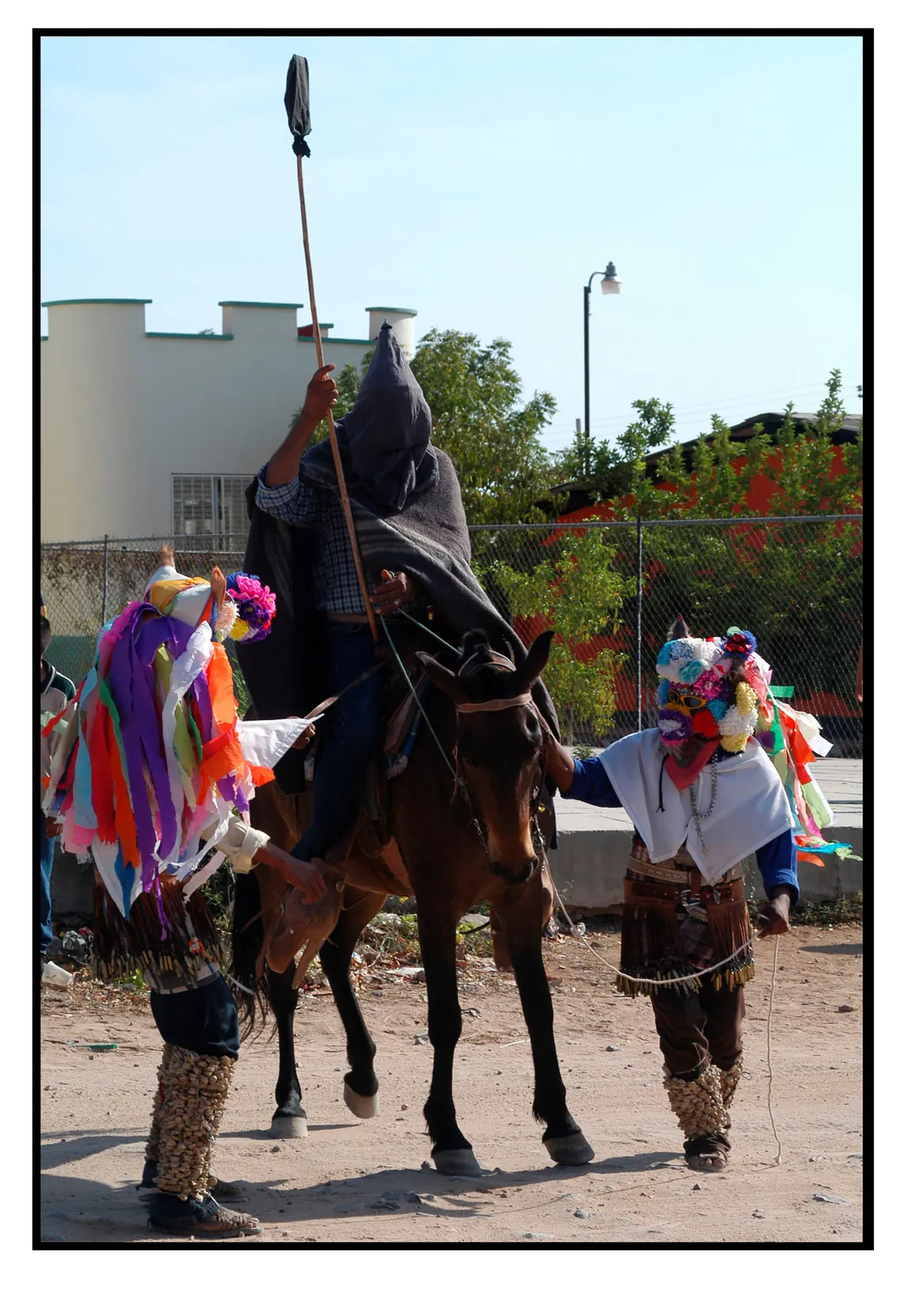The James S. Griffith Collection of Mayo and Yoeme Pascola Masks
What is a Pascola?
The Mayo Indians celebrate more than 70 religious festivities. The most important ones are Fiesta de la Santísima Trinidad, San José, El Espíritu Santo, San Ignacio de Loyola, Santa Cruz, Virgen de Guadalupe, San Juan, San Miguel Arcángel, and Semana Santa (Holy Week). Although these are Catholic celebrations, they contain local traditional elements, such as the maaso (deer) dancer and pascolas, that distinguish the Mayo celebrations from celebrations elsewhere. The pascola, the capakóbam (Fig. 4.1), the pariserom, and the Piláto (Fig. 4.2), are some of the many personages that capture and represent the richness of today’s Mayo cultural traditions. The material objects that the dancers use, the music, and the social/cultural functions performed by the pascolas might serve to indicate that at least in contemporary times a strong integration exists of the European Catholic and local native worlds.

Mayo Pilato, Masiaca, Sonora
photo courtesy Emiliano Gallaga
The pascola stands out as a dancer, a host, a speaker, and as community ritual clown. His presence is visible through the dances and heard in the music. He appears in oral traditions and through the manufacture of specific crafts associated with his performance (Aguilar 1995;Crumrine 1990). In spite of his importance, the origin or meaning of the term pascola is ambiguous. At least two explanations prevail:
- Colonial origin: pascola may derive from the Spanish term pascua and stand in direct relation with the Catholic ceremony of the Pascua de Resurrección (Lent). If so, this would suggest that the pascola is a cultural development originating from the interaction between the Catholic ceremonies taught by Jesuit missionaries during the 17th century and already existing local indigenous traditions.
- Prehispanic origin: pascola may come from the Cahita word pahko’ola, which literally means “the old man of the ceremony,” or from pahko, which translates as “ceremony.”
The term pascola is not exclusive to the Mayos, however. Employed among the Ra’ramuri (Tarahumara), O’odham (formerly Pápago, Pima), Tepehuanos del Norte, Comca’ac (Seri), Macurawe (Guarijío), and Yoeme (Yaqui), the pascola dance survives as a typical North Mexican tradition among the indigenous groups of this region. Today, the pascola tradition is particularly strong among the Mayo, the Yoeme, and the Guarijío, who believe that a fiesta is not a fiesta if there is no pascola dancer.
In addition to a white cotton long-sleeve shirt (Fig. 4.3), the Mayo pascola dancer wears a manta or white blanket that is wrapped around the waist and legs, and secured with a leather belt (koyolim).

Mayo pascola dancer attire, Tres Cruces, Sonora
photo courtesy Emiliano Gallaga
The belt has several metallic bells attached that sound when the pascola moves. A wooden rattle (sena’asom) with small metallic discs is used when the pascola dances. The sena’asom is tucked under the belt when the pascolas dance to the music of the harp and violin. Perhaps the most characteristic element of the pascola dancers is the tenevoim, or string of giant silk moth cocoons filled with fine stones or sand from ant hills, that is worn wrapped around each of the dancer’s legs. The unique sound made by the tenevoim (or, in Spanish, tenábaris) resemble that made by a rattlesnake, an animal culturally associated with rain and fertility. A pascola dancer demonstrates his skill by the way he makes the tenaboim rattle. The pascolas go barefoot.
Mayo pascolas complement their attire with two distinctive elements: a wooden mask and la vela (the candle). The mask represents the yo aniya or the wild mountain spirit who is believed to be the dancer’s mentor during the pascola performance. When the pascola dances as a human being, the mask is moved to the back of the head or over one ear, leaving the dancer’s face uncovered. When the dancer wishes to represent an animal, the mask covers the face and the dancer adopts the personality of the being he is presenting. “La vela” is a lock of hair to which a paper flower (sewa) is attached. The flower represents the good and protective forces and is associated with the Virgen María and the regenerative forces from the huya aniya (supernatural/magical world). “La vela” thus symbolizes the union between the pascola and those benevolent forces (Aguilar 1995;Crumrine 1990).
A harp and a violin, originally brought by the Europeans, together with a cane flute and a hide drum, representing the indigenous side, accompany the pascolas in perfect harmony. The music and the dance performed by the pascola represent the ritual communication between the Mayo communities and the huya aniya(supernatural/magical world).





